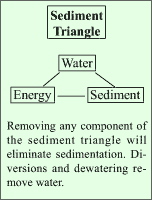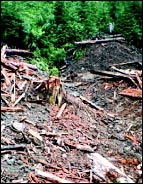| Forest Road Deactivation Practices | |
| in the Pacific Northwest | |
| 6 - Sediment Control | Planning, Catch Basins, Fine-Textured Soil |
Dealing with sediment is more difficult than preventing sediment transport and erosion. The Sediment Triangle shows that removing water or reducing energy  is more effective in sediment prevention than trying to remove sediment sources.
is more effective in sediment prevention than trying to remove sediment sources.
Deactivating a drainage structure has the potential to release more sediment than was introduced during the construction. Where fish habitat and water quality concerns are strong, drainage structures should be removed during periods of low or no water flows. Fish removal and dewatering streams may sometimes be the only option to work outside regional fisheries windows. In some cases, portions of a structure may be left in place permanently, i.e., pilings or cribbing of log bridges, if they provide suitable habitat. Confirm whether agency approval is required.
Sediment release from deactivated roads is commonly the result of exposed soil falling or ravelling into a stream, or of water flows eroding materials. Protect erodible materials from rain and water flows, and use stable cut/ fill slope angles. If blanketing or armouring is required, complete it as soon as possible. Use coarse, clean material to armour stream channel banks to levels of peak flow estimates. If you anticipate sediment, build a downstream dam and pump silty water onto non-erodible sites in the adjacent forest until water runs clear.
In non-fish streams, catch basins or sediment ponds (settling ponds) may be constructed directly downstream from the structure to be deactivated. This allows heavier suspended particles to settle out before they reach fish habitat. Use sandbags, gabions (wire baskets filled with small rocks), and geotextiles if rock is not nearby. Catch basins are most effective when they are constructed long, wide and shallow.

When working in fine-textured soil without rock available nearby, there are two effective measures to minimize sediment generation: schedule work in relatively dry conditions, and establish proper width-depth relationships for cross-ditches. In silts, use slope ratios less than 5:1 for cross-ditches. Logs and stumps also provide effective initial surface erosion prevention on deactivated slopes, followed by prompt revegetation. Maintain water control to prevent fine-textured material mixing with water during deactivation, thereby reducing water quality. Rock placed in ditchlines to slow water flow, trap sediment, and prevent erosion, is a more permanent solution. Use hay bales, silt fences, and similar products as temporary measures only. You must remove these measures if a deactivation inspection has determined that the site has stabilized. Don't leave the removal of these temporary measures "for some time in the future or someone else to do". If you can not avoid adverse environmental and financial effects, consider a voluntary shutdown.
| 6 - Sediment Control |
| Next |
||
|
Sediment Control 6
|
|
|
©1999 - 2002 Flip Productions Limited Used with permission by CulvertBC |